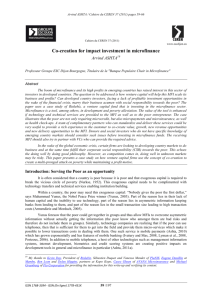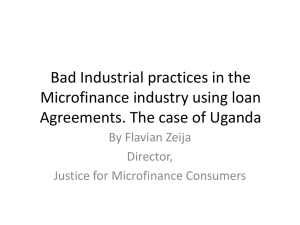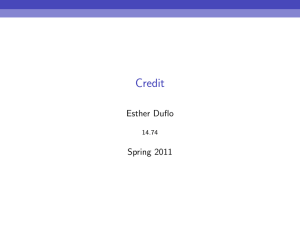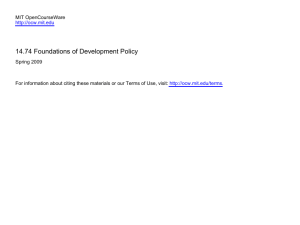Microcredit Best Practice
advertisement
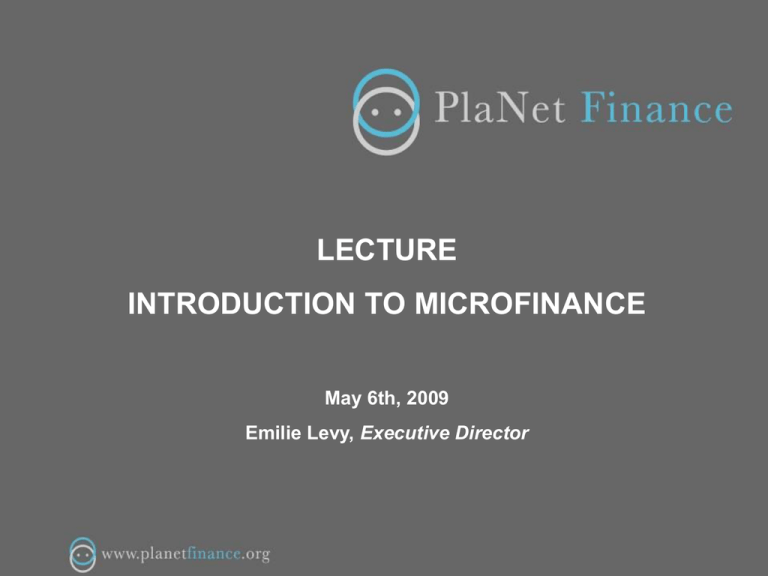
LECTURE INTRODUCTION TO MICROFINANCE May 6th, 2009 Emilie Levy, Executive Director 1/16 Agenda DEFINITION OF MICROFINANCE STAKEHOLDERS MICROFINANCE BEST PRACTICES SUSTAINABILITY AND RISKS SNAPSHOT OF MICROFINANCE TODAY 2/16 Case study Mrs. Israel, 48 years old • • • • Unemployed husband 4 children No savings Good cook • Mrs. Israel decides to start a small catering service at home Mrs. Israel goes to the bank and makes a demand for a loan at her bank • MRS. ISRAEL’S DEMAND IS REJECTED 3/16 Justification and definition of microfinance Why are people excluded from certain financial services? • Lack collateral or guarantors • A bad credit history • Gap in the communication / lack of confidence in the Banks • Doubt of the bank of the repayment capacity • Lack of access to financial infrastructure and services in remoted areas WHAT IS THE ALTERNATIVE? MICROFINANCE 4/16 Justification and definition of microfinance MICRO FINANCE • Micro-entrepreneurs • Business & educational loans • Self-employed • Savings • Low income populations • Micro-insurances • Excluded populations • Remittances • Micro-entrepreneur training • Coaching & workshops on health, hygiene, etc. 5/16 Definition Microfinance is the offer of financial & non-financial services to people excluded from the traditional banking system. The services are adapted to the needs of the target populations Microfinance is a tool against poverty by enabling the beneficiaries to : • Create sustainable activities to increase their incomes • Reduce external shocks • Improve the living conditions of entrepreneurs and of their families • Empower people and mainly the women 6/16 Introduction to Microfinance: History How did all start? • • On the field Prof. Yunus saw that Even poor people and women need loans They can have an activity and repay Yunus’ idea Prof. Muhammed Yunus Founder of the Grameen Bank, Bangladesh • Set up financial institutions with a social mission • Listen to the needs and constraints of the excluded & offer them adapted financial tools to empower themselves ( solidarity groups) Spirit: SUSTAINABILITY 7/16 Actors & Mechanisms COMMERCIAL BANKS & INVESTMENT FUNDS GOVERNMENT & LOCAL BODIES FOUNDATIONS & DONORS (incl. enterprises) MICROFINANCE INSTITUTIONS (MFIs) (NGO, ASSOCIATIONS & BANKS) SUPPORT ORANIZATIONS (e.g. PF) Commercial Banks BENEFICIARIES 8/16 Micro-credit Best practices (1/4 ): microcredit Mrs. Israel needs NIS 1,000 1 Visit of Mrs. Israel to the MFI Meeting wit the Loan Officer 2 Start of cooking & sale Convinced, reception of a loan of NIS 1,000 (+ NIS 30 interest rate) 4 Purchase of the ingredients (Daily benefits amount NIS 100) Regular contact and follow up between the MFI and the client Final Repayment 12 weeks later Demand for a 2nd loan over NIS 1500 to buy a fridge) 3 Weekly Repayment ( 86 NIS) Remaining money is used to buy food 9/16 Microcredit Best Practice (2/4 ) Repayment Microfinance is not philanthropy! • Clients need to pay for the services • Microcredit clients need to repay the loans • Interest rate to cover the costs Why is repayment important? • Offer new loans and extend the client base • Ensure correct functioning and growth of the institution • Cover office & operational costs • Cover for non-payments when they occur • Avoid financial loss and loss of credibility for the institution REPAYMENT ON TIME GUARANTEES THE SUSTAINABILITY OF THE PROGRAM 10/16 Micro-credit Best practices (3/4 ): Interest Rate Prejudices • The social mission should consist in a free loan • Interest Rate, perceived as a burden to the client Reality • Micro-credits allow for the creation or expansion of an income generating activity and the generation of profit • Interest rates are no burden if the business plan is solid and good evaluation has been done 11/16 Microcredit Best practices (4/4): Key success factors Methodology • Regular follow up • Requirement of good repayment for future access to a bigger loan • Local loan officers familiar with local culture Adapted products and procedures • Small and short term credits • Repayment capacity assessment • Adapted collaterals / group solidarity guarantee Business Development Services • Compensation for lack of education of loan beneficiaries 12/16 Sustainability: the conceptual framework OUTREACH SUSTAINABILITY IMPACT Why few MFIs are sustainable? How do we measure the impact? • Need to make trade-off sometimes • Need to reduce the internal and external risks to maximize the success 13/16 Microfinance in the world today • 10,000 MFIs manage a global portfolio of US$30 Billions • In a range from 150 US$ to 7,000 US$, the average loan size is US$ 450 • 150 Mio micro-credit active clients • 300 Mio micro-saving active clients • 50 Mio micro-insurance active clients Sources : CGAP, BIT, Microcredit Summit, PlaNet Finance 14/16 New trends • Development of MF in industrialized countries (e.g. Israel, France, USA) thanks to the adaptation of the tools and methodologies • Commercialization of the stakeholders • Use of new technologies as a new development tool 15/16 Thank you! www.planetfinancegroup.org elevy@planetfinance.org 16/16





